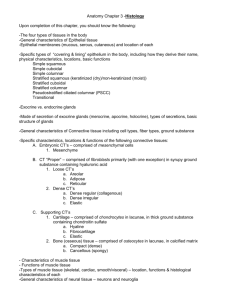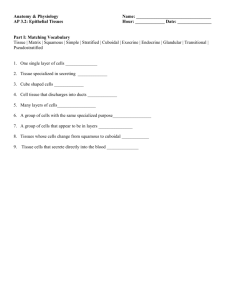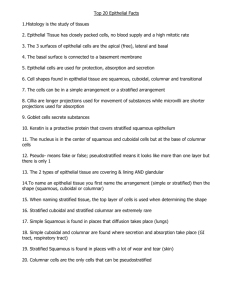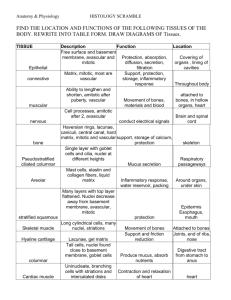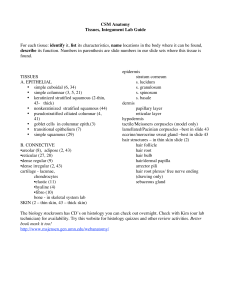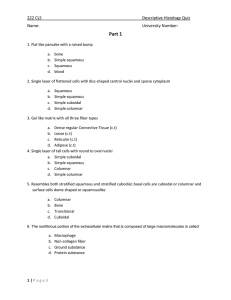lab preparation
advertisement
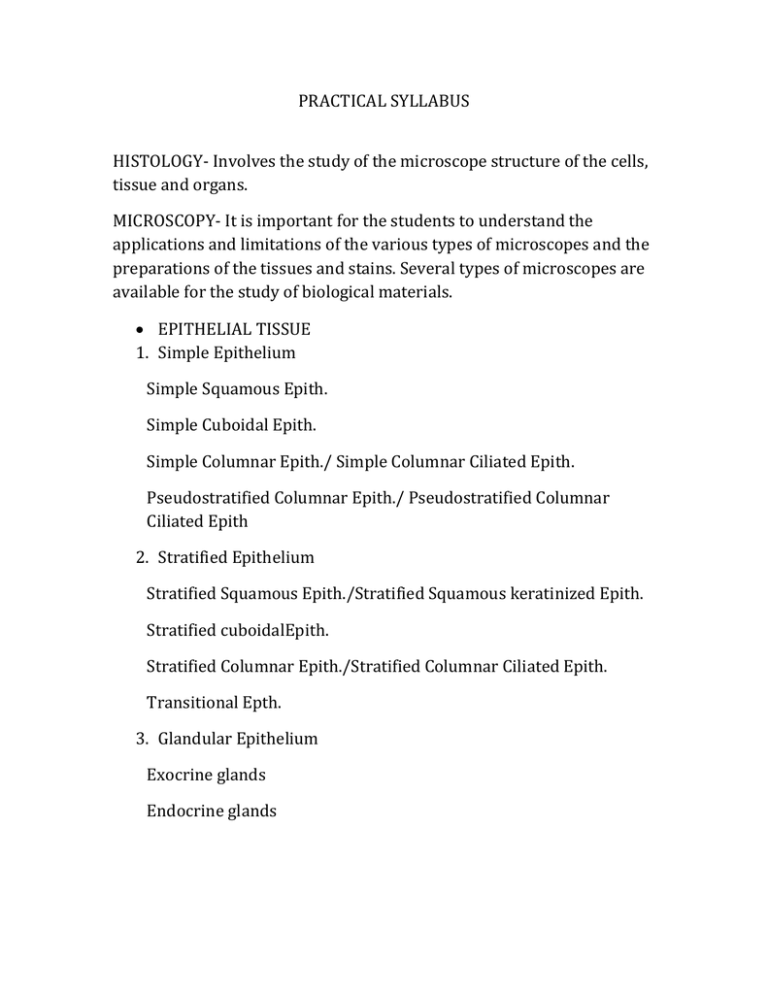
PRACTICAL SYLLABUS HISTOLOGY- Involves the study of the microscope structure of the cells, tissue and organs. MICROSCOPY- It is important for the students to understand the applications and limitations of the various types of microscopes and the preparations of the tissues and stains. Several types of microscopes are available for the study of biological materials. EPITHELIAL TISSUE 1. Simple Epithelium Simple Squamous Epith. Simple Cuboidal Epith. Simple Columnar Epith./ Simple Columnar Ciliated Epith. Pseudostratified Columnar Epith./ Pseudostratified Columnar Ciliated Epith 2. Stratified Epithelium Stratified Squamous Epith./Stratified Squamous keratinized Epith. Stratified cuboidalEpith. Stratified Columnar Epith./Stratified Columnar Ciliated Epith. Transitional Epth. 3. Glandular Epithelium Exocrine glands Endocrine glands CONNECTIVE TISSUE Areolar C.T Mucoid C.T Adipose C.T Reticular C.t White Collagenous C.T Yellow elastic C.T CARTILAGE Hyaline Cartilage Elastic Cartilage White Fibro Cartilage BONE Compact Bone Spongy Bone MUSCULAR TISSUE Smooth Muscle Skeletal Muscle Cardiac Muscle NERVOUS TISSUE Nerve cells Peripheral Nerve (nerve trunk) BLOOD VASCULAR SYSTEM Artery & Vein Aorta LYMPHATIC SYSTEM Lymph Nodes Spleen Tonsils Thymus RESPIRATORY SYSTEM Trachea Lungs DIGESTIVE SYSTEM Lips Salivary Glands: Submandibular Gland, Sublingual Gland. Digestive tube: Oesophagus, Gastro-oesophagus junction. Stomach: Cardiac Region, Fundus Region, Pyloric Region. Small Intestine: Duodenum, Jejunum, Ilium. Large Intestine: Caecum, Appendix, Ascending and transverse and Descending Colon, Rectum. Liver Pancreas URINARY SYSTEM: Kidney UreterBladder LAB PREPARATION Magnification used to examine slides: 10X and 40X. After each lab, the students should submit the sketchbook with drawings of what they have seen under the microscope in the previous lab. PACTICAL 1: INTRODUCTION Demonstration of : 1. Light microscopes. 2. Electron microscopes. Introduction to different cell parts. PACTICAL 2: EPITHELIAL TISSUE 1. 2. 3. 4. 5. 6. 7. Simple Squamous Epith. Simple Cuboidal Epith. Simple Columnar Epith. Pseudostratified Columnar Ciliated Epith. Stratified Squamous Epith. Stratified Squamous keratinized Epith. Transitional Epith. PACTICAL 3: CONNECTIVE TISSUE 1. 2. 3. 4. 5. 6. Areolar C.T. Mucoid C.T. Adipose C.T. Reticular C.T. White Collagenous C.T (regular/irregular). Yellow elastic C.T. PACTICAL 4: CARTILAGE 1. Hyaline Cartilage. 2. Elastic Cartilage. PACTICAL 5: BONE 1. Compact Bone. 2. Spongy Bone. PACTICAL 6: MUSCULAR TISSUE + QUIZ REVISION* 1. Smooth Muscle. 2. Skeletal Muscle. 3. Cardiac Muscle. PACTICAL 7: NERVOUS TISSUE + QUIZ* 1. Nerve cells. 2. Peripheral Nerve (nerve trunk). PACTICAL 8: BLOOD VASCULAR SYSTEM 1. Artery & Vein. 2. Aorta. PACTICAL 9: LYMPHATIC SYSTEM 1. 2. 3. 4. Lymph Nodes. Spleen. Tonsils. Thymus. PACTICAL 10: RESPIRATORY SYSTEM 1. Trachea. 2. Lungs. PACTICAL 11: 1ST HALF OF THE DIJESCTIVE SYSTEMDIGESTIVE SYSTEM 1. 2. 3. 4. 5. Lips. Salivary Glands: Submandibular Gland, Sublingual Gland. Digestive tube: Oesophagus, Gastro-oesophagus junction. Stomach: Cardiac Region, Fundus Region, Pyloric Region. Small Intestine: Duodenum, Ilium. PACTICAL 12: 2ND HALF OF THE DIJESCTIVE SYSTEMDIGESTIVE SYSTEM 1. Large Intestine: Appendix, Colon. 2. Liver. 3. Pancreas. PACTICAL 13: URINARY SYSTEM 1. Kidney. 2. Ureter. 3. Bladder. REVISION PACTICAL 14: FINAL PRACTICAL EXAM Revision: Allow the students to review their information by showing them all the previously mentioned microscope slides covering all the topics. Quiz and final exam: Spot examination: Slide identification. Side question.
